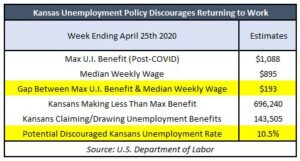Kansas lockdown and social distancing rules to combat COVID-19 have led to massive unemployment. With claims for unemployment benefits hitting record levels, the state’s real unemployment rate is likely well above 10%. Governor Kelly must change unemployment benefits policy to encourage work. Otherwise, the full Kansas economic recovery from COVID-19 may not start until well into the summer.
The federal CARES Act intended to provide relief to those out of work during the COVID-19 pandemic. Part of that package is providing an additional $600/week unemployment benefit through July 31st. If employers or government lockdowns force Kansans to stay home, they should have some semblance of financial stability. However, there must be a balance. In some states, generous unemployment benefits encouraged workers to ask for a furlough. In Kansas, positive COVID-19 cases on the decline, with strong desires to end the Kansas government lockdowns. One-sized-fits-all plans, like the unemployment provisions of the CARES Act, need tailoring to a Kansas re-opening plan. Otherwise, it could discourage Kansans from going back to work, extending the economic recession.
We compared the state’s maximum unemployment benefit to its median wage to assess the level of Kansas worker “discouragement.” For 2020, the maximum Kansans can receive from the state is $488 a week in unemployment benefits. Couple this with the $600/week from the Cares Act, and the maximum weekly benefit climbs to $1,088. According to Kansas wage and occupational data, the median weekly wage is $895. In other words, potentially half of all Kansas workers can “earn” at least an extra $200 by not working and drawing unemployment insurance. The table below outlines our findings.
 As of the week ending April 25th, 2020, 143,505 Kansans either filed a claim or are currently receiving a state unemployment payout. As a share of the insured labor force, Kansas could have a discouraged-from-working unemployment rate, as high as 10.5%. Moreover, this is not an exaggeration. Kansas Labor Secretary Garcia admitted that from March to Mid-May, the state’s received 236,412 initial claims, 115,536 continued claims, and roughly 200,000 calls a day.
As of the week ending April 25th, 2020, 143,505 Kansans either filed a claim or are currently receiving a state unemployment payout. As a share of the insured labor force, Kansas could have a discouraged-from-working unemployment rate, as high as 10.5%. Moreover, this is not an exaggeration. Kansas Labor Secretary Garcia admitted that from March to Mid-May, the state’s received 236,412 initial claims, 115,536 continued claims, and roughly 200,000 calls a day.
As time goes on, this discouraged-from-working unemployment rate will rise. The Kansas economy, let alone the government, cannot survive if half of the workforce doesn’t produce. Additionally, the Kansas policy that allows unemployment benefits to last for six months, regardless of ‘Kansas’ economic health, will slow recovery too. To avoid this, Governor Kelly can follow the example set in Georgia. There, Governor Kemp and the Georgia Department of Labor increased the earnings exemption on state unemployment benefits to $300/week. Georgians can make up to $300/week at a job and retain the unemployment benefits (including the federal $600 payout). Any dollar above the $300 a week threshold lowers unemployment benefits.
There should be a safety net for those who suddenly find themselves unemployed. However, we must remember that generous unemployment benefits invite abuse and dependency. Research studies confirm high unemployment benefits increase unemployment rates. If the unemployment benefit is larger than your paycheck, then not working makes sense. When it’s time for Kansans to be productive, the safety net should not harm those it means to help.
Kansas government cannot simultaneously encourage both employment and unemployment. Easing the Kansas lockdown and returning the economy to pre-COVID-19 levels, means government policy rewards Kansans’ desire to work. With a COVID-19 economic impact slated to hit Kansas tax revenues to the tune of a few billion dollars, government policies to discourage work is no longer what Kansans need right now.




